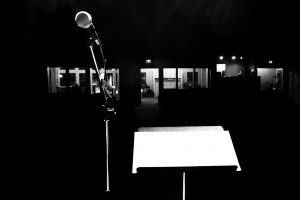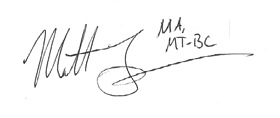Recording music often becomes part of the therapeutic process for many music therapists and their clients or patients. Recording technology might very well be a part of the music therapist’s tool kit, and can be used for songwriting, legacy creation, family support activities, music assisted relaxation, and so forth and so on. As technology continues to change, it is becoming easier and easier to produce high quality recordings.
Just as we strive for quality in our live music production, we should aim to produce audio recordings that are well-done and pleasing to the ears. The good news – which I have already mentioned – is that it is becoming easier and easier to do this. In this post, I’m going to talk primarily about equipment you can use to achieve a good sound. I’m also going to provide options at different price points, as we all have different budgets within which we can work.
A note about the links: they are just suggestions of products, and I can’t officially endorse any of them. If there is a brand that you are more comfortable with, go for it. Read some reviews and get what makes sense for you. Also, if you do buy through these links, you are supporting Music Therapy Source because a small percentage of the sale goes back to the website. This helps greatly with the hosting and maintenance fees. So if you choose to buy through these links, thank you!
Option One – El Cheapo
What you need:
The computer you already use + Audacity recording software (free) + USB Microphone + Headphones
This setup will allow you to record acoustic instruments and your voice for a rather inexpensive price tag. You will want to use the headphones as a monitor, especially if you layer instrumental or vocal tracks. This way earlier recordings won’t “bleed through” to new tracks within the same song. You will want to configure Audacity so that it uses the USB mic to pick up sound, rather than the internal microphone on your speaker. If you have a Mac, you don’t even need to download Audacity, because you probably have GarageBand.
Option Two – Middle of the Road with a Mac
What you need:
The computer you already use (assuming it’s functioning well) + audio interface + MIDI controller + USB Microphone or Recording Mic + Headphones + Studio Monitors (optional)
With this setup, you don’t need to get any extra software because it’s very likely that you have GarageBand. This is actually some really powerful software, and you can do a lot within it. You can make very basic recordings, or really complex ones. At this price range, you will probably want an audio interface. This allows you to plug an analog instrument (guitar, bass, etc) into the interface, which converts it into digital sound waves that can be recorded by GarageBand.
If you typically use piano for recording, you might opt instead (or in addition) for the MIDI controller, which allows you to control software instruments within the recording program. This includes a variety of piano sounds, but also a wide range of other instruments, such as drums and percussion, synthesizers, woodwinds, brass, and obscure and even made-up instruments. For a microphone, you can either use a USB mic and plug directly into the computer, or you can use a regular mic with an XLR (3-pronged) output. This mic is actually considered more of a live sound mic, but I prefer its sound to many other “recording mic” in the same price range. You will need headphones for monitoring and mixing, and if you want to mix without headphones, you can get some inexpensive studio monitors.

Option Two – Middle of the Road with a PC
You can basically get all the same components as Option Two with a Mac, but you will need the software with which to record. You can download Audacity for free, but if you want more sound options, you might consider purchasing this package of entry level software (ProTools Express) and an audio interface.
Option Three – I’ll Take the Cadillac, Please
So you just got that $30,000 technology grant, huh? Nice! Here are some options for setting up a sweet music therapy recording studio. Of course, you can mix and match with other items. It is just fun to put together a “someday maybe…” list
First, you have to get a big, powerful MacBook Pro
Download Logic X from the App store (sorry, don’t have a link for this)
Get an audio interface with plenty of inputs, such as the Focusrite Scarlett 18i20 USB 2.0 Audio Interface With Eight Focusrite Microphone Preamplifiers
For monitoring and mixing, pick up some Audio-Technica ATH-M50 Professional Studio Monitor Headphones with Coiled Cable
These will suffice as studio monitors:KRK RP5G3-NA Rokit 5 Generation 3 Powered Studio Monitor – Pair
And for a microphone, try the Audio-Technica AT2035 Large Diaphragm Studio Condenser Microphone
You will need cables and stands for many of these things, which you can also find on Amazon or pick up at your local music store.
As you can see, there are many options when it comes to purchasing recording equipment for your practice or program. While I may have done some of the work for you, it is still important to research each product and decide what makes the most sense for your clinical situation. I’ve enjoyed putting these lists together. I wish you the best of luck in your upcoming recording projects!


Hi Matt!
Great Post! I have been operating Logic Pro X for several large projects this semester and dig it the more I get to use it, I do prefer Ableton live for mixing and playing with sampling though. For in home stuff I will use my interface and mic but in patient rooms and for recording podcast I use the Yeti USB mic and it is AWESOME http://bluemic.com/yeti/ It was around $100 and has been a great investment-Highly recommend for anyone starting out!!!
I would also recommend the irig midi keyboard which can also connect to your i-pad AND Logic has an ipad app for remote mixing!
Cheers and keep up the great blogging : )
Caitlin
Thanks for the input, Caitlin! I use the Yeti as well – it’s a great mic. Logic Pro X looks amazing – I’m still rocking 9. Great to hear from you!
Matt